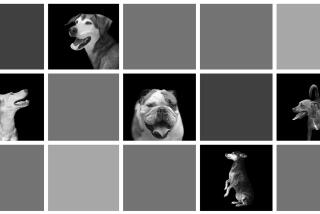Recruits in War Veteran’s Army Wear Dog Tags--and Collars
- Share via
Pvt. Kami saluted smartly. Or was she just scratching a flea behind her ear the other day?
It’s hard to tell when the dogfaces in this man’s army line up for inspection.
That’s because Joseph J. White’s recruits are dogs--animals enlisted in an unusual campaign to build a national monument honoring America’s military canine corps.
His force is composed of animals with honorary ranks purchased by pet owners as contributions to a proposed $550,000 bronze and marble war dog statue in Washington. There are $3 privates, $25 lieutenants and $300 generals among the tail-wagging troops.
About 13,325 real-life military dogs have guarded American soldiers, hunted for hidden enemy positions and carried battlefield messages over the past 75 years, according to supporters of the memorial. That includes 125 dogs that were dispatched to sniff out buried desert land mines during the recent Persian Gulf War.
“These dogs that have been sent around the world to save lives deserve a pat on the back,” said Joyce Lincoln as she gave her 2-year-old Doberman pinscher Kami a pat on the head this week at her West Hills home.
Along with Kami, the retired aerospace manager has posthumously enlisted four previously owned dogs in White’s army to help pay for the monument.
The memorial is a personal crusade for White, 42, of Jacksonville, Fla. He says he and about 200 other American GIs are alive because of a dog that was donated for Vietnam war service by a Los Angeles family.
White was an Army dog-handler assigned to a 32-man “scout-dog platoon” in South Vietnam during 1970. His dog was a jet-black female German shepherd named Ebony.
Ebony became a hero on one of their patrols in a mountainous jungle area near Hue, according to White.
The dog heard noises from the dense forest as she and White led a reconnaissance squad down a trail. Freezing in her tracks and staring into the woods, she alerted White in time for him to silently motion for a tear-gas grenade to be tossed into the trees.
“After that, we could hear all of those guys who had been hiding in there run off,” he said. “A whole North Vietnamese army unit had been waiting to ambush us. We’d all have been wiped out if it hadn’t been for Ebony.”
Off duty, Ebony would entertain troops by falling to the ground and lying still whenever White asked, “Ebony, would you rather be dead, or be in the Army?”
“She’d give smiles to people who really needed a smile. We were in places where no USO shows would go,” White said. Ebony was transferred to a South Vietnamese military unit when Americans were pulled out of the area in mid-1971, he added.
Jan Craig Swann, 55, a North Hollywood resident who donated Ebony for military service in late 1967, was shocked when told this week of the dog’s heroism--and of it being the inspiration for the war dogs monument.
“That’s unbelievable, wonderful!” she exclaimed by telephone from Raymore, Mo., where she now lives. “This is going to make me cry.”
Although muscular German shepherds and Belgian malinois dogs are used these days by the U.S. military, about 30 other breeds and assorted mixed-breeds have been used in the past, according to Hildegarde Brown, spokeswoman for the Department of Defense’s Military Working Dog Agency.
Her organization, headquartered at Lackland Air Force Base in San Antonio, Tex., purchases and trains about 400 dogs a year for military and Federal Aviation Administration use. The FAA uses Labrador and golden retrievers to sniff out drugs and explosives at airports, she said.
White said he launched the National War Dogs Memorial Project about three years ago after learning that countries such as Japan, Germany, France and the Soviet Union have canine corps monuments--but the United States does not.
It has been a slow campaign, however.
Only about $15,000 has been raised, he said, even though he has quit his job as an Orange County-based missionary to Vietnamese refugees to promote the project full time. While his goal is to enlist 20,000 animals in his symbolic dog army, only 637 have been recruited.
Although the campaign until now has been aimed at dog-lovers, White and his backers say they plan to involve veterans’ groups and manufacturers of pet products.
“I’m convinced we’re going to succeed,” said project Vice President Charlie Norton, a retired Marine lieutenant colonel now working as a winery sales manager in Tracy, Calif. “We’re not trying to humanize dogs with this. But the fact of the matter is the dog has played a major part and it deserves to be recognized.”
Back on the home front, meantime, Pvt. Kami is awaiting a promotion of her own. Paperwork has been submitted--including a check for $50--to advance the high-spirited Doberman to the rank of major, said pet-owner Lincoln.
“Kami’s taking obedience training,” Lincoln said. “She’s learning about following orders. I think she has a good chance of making general.”
More to Read
Sign up for Essential California
The most important California stories and recommendations in your inbox every morning.
You may occasionally receive promotional content from the Los Angeles Times.














